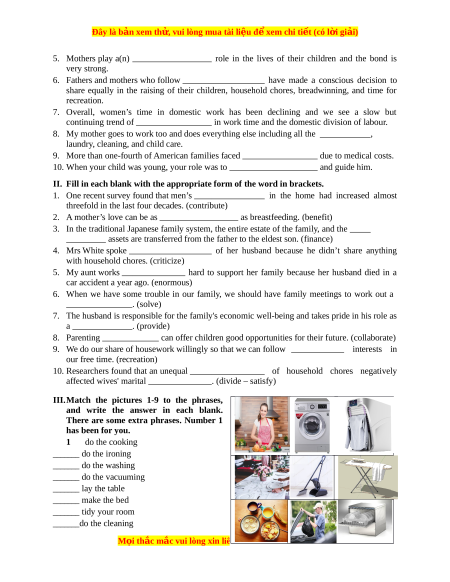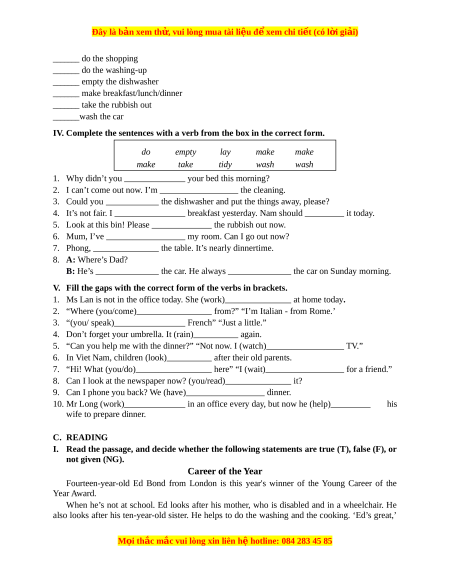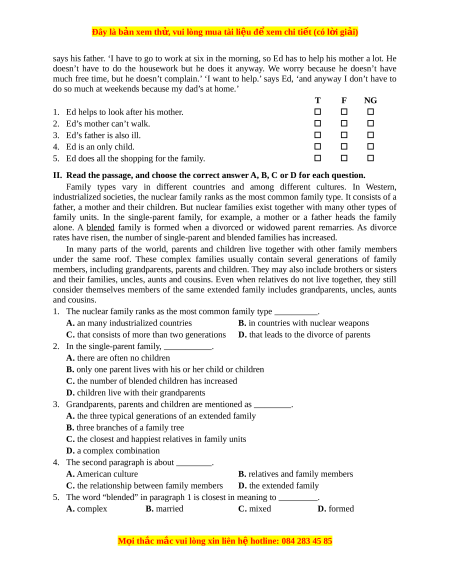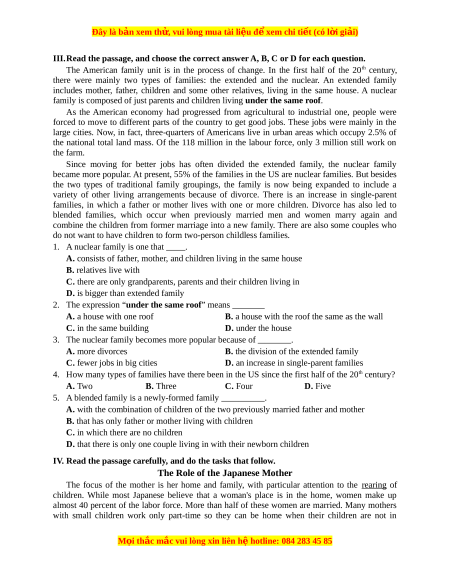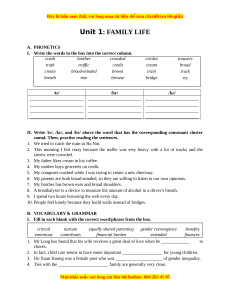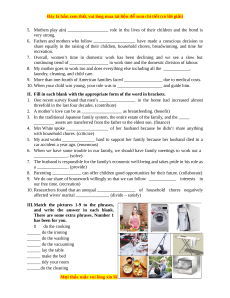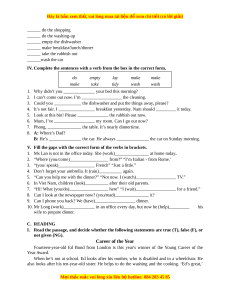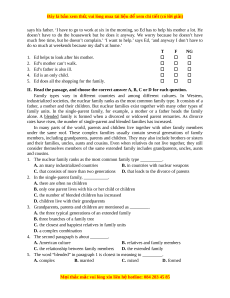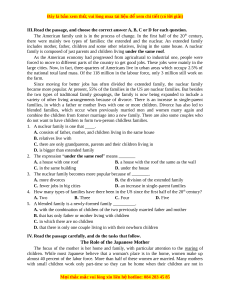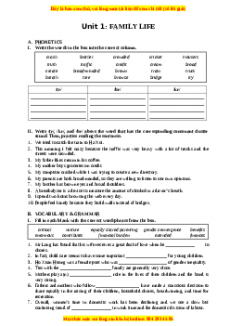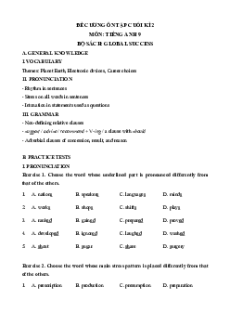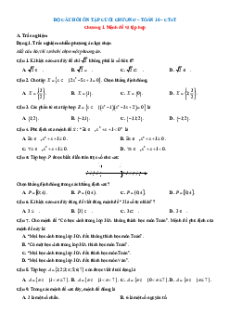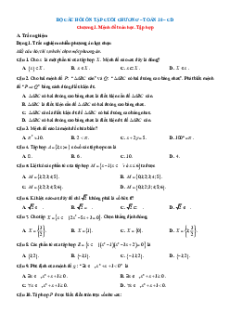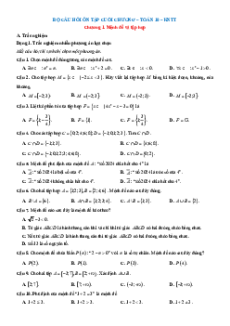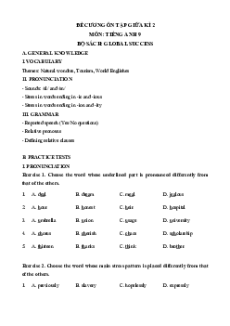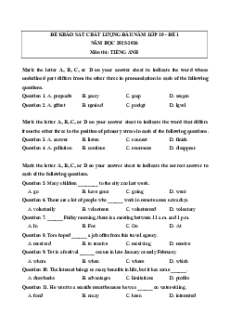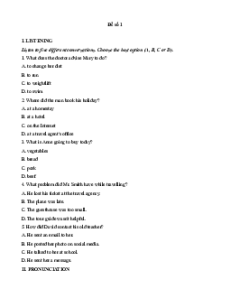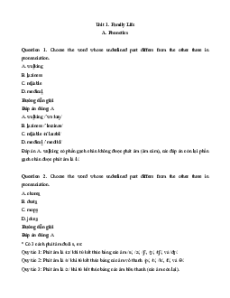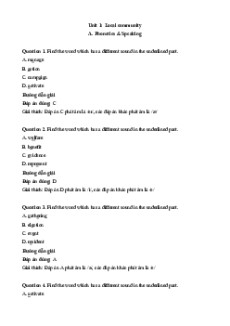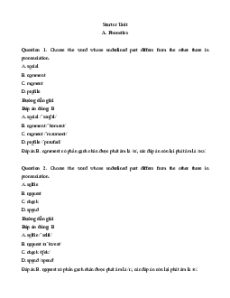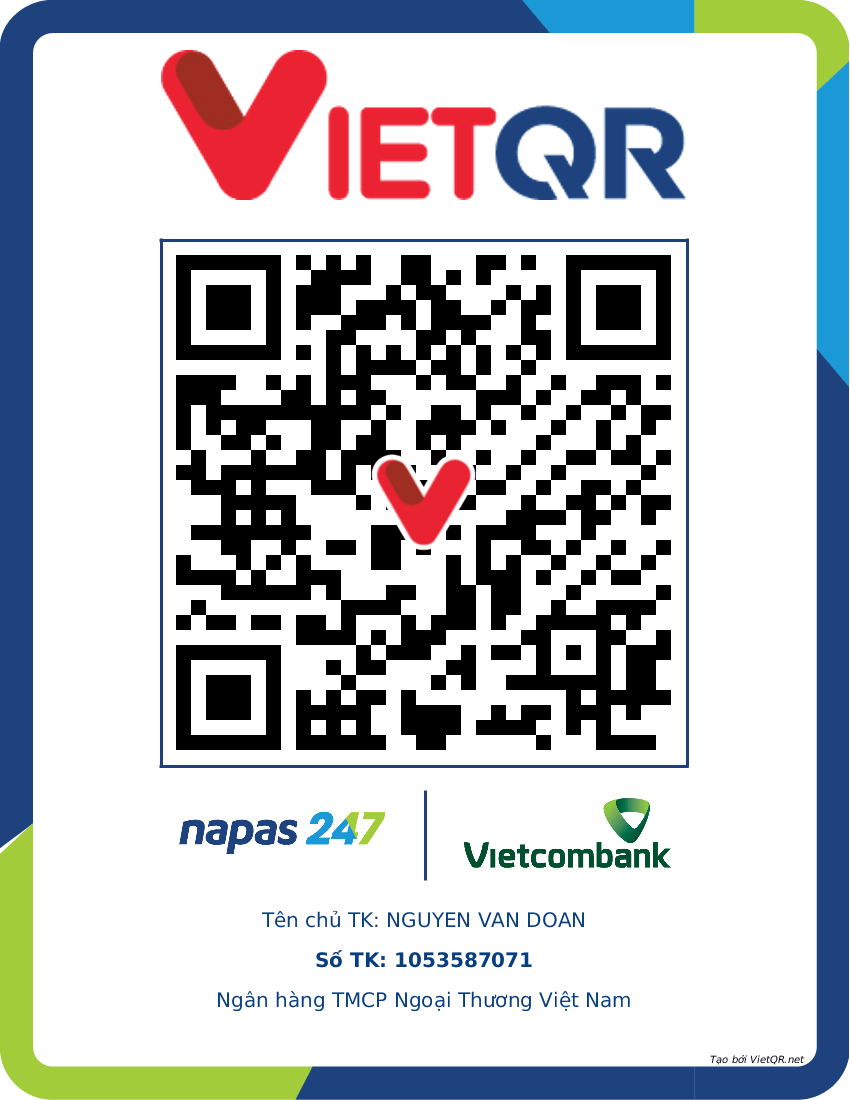Đây là bản xem th , vu ử i lòng mua tài li u ệ đ xe ể m chi ti t ế (có l i ờ gi i ả ) Unit 1: FAMILY LIFE A. PHONETICS
I. Write the words in the box into the correct column. crash brother crowded cricket trousers truth traffic credit cream broad create broad-minded brown train truck breath tree browse bridge try /tr/ /br/ /kr/
II. Write /tr/, /kr/, and /br/ above the word that has the corresponding consonant cluster
sound. Then, practise reading the sentences.
1. We tried to catch the train to Ha Noi.
2. This morning I felt crazy because the traffic was very heavy with a lot of trucks and the streets were crowded.
3. My father likes cream in his coffee.
4. My mother buys groceries on credit.
5. My computer crashed while I was trying to create a new directory.
6. My parents are both broad-minded, so they are willing to listen to our own opinions.
7. My brother has brown eyes and broad shoulders.
8. A breathalyser is a device to measure the amount of alcohol in a driver’s breath.
9. I spend two hours browsing the web every day.
10. People feel lonely because they build walls instead of bridges. B. VOCABULARY & GRAMMAR
I. Fill in each blank with the correct word/phrase from the box. critical nurture
equally shared parenting gender convergence benefits enormous contributes financial burden extended finances
1. Mr Long has found that his wife receives a great deal of love when he to chores.
2. In fact, child care seems to have some important for young children.
3. Ho Xuan Huong was a female poet who was of gender inequality. 4. Ties with the
family are generally very close. M i
ọ thắc mắc vui lòng xin liên h h
ệ otline: 084 283 45 85
Đây là bản xem th , vu ử i lòng mua tài li u ệ đ xe ể m chi ti t ế (có l i ờ gi i ả ) 5. Mothers play a(n)
role in the lives of their children and the bond is very strong.
6. Fathers and mothers who follow
have made a conscious decision to
share equally in the raising of their children, household chores, breadwinning, and time for recreation.
7. Overall, women’s time in domestic work has been declining and we see a slow but continuing trend of
in work time and the domestic division of labour.
8. My mother goes to work too and does everything else including all the ,
laundry, cleaning, and child care.
9. More than one-fourth of American families faced due to medical costs.
10. When your child was young, your role was to and guide him.
II. Fill in each blank with the appropriate form of the word in brackets.
1. One recent survey found that men’s
in the home had increased almost
threefold in the last four decades. (contribute)
2. A mother’s love can be as as breastfeeding. (benefit)
3. In the traditional Japanese family system, the entire estate of the family, and the
assets are transferred from the father to the eldest son. (finance) 4. Mrs White spoke
of her husband because he didn’t share anything
with household chores. (criticize) 5. My aunt works
hard to support her family because her husband died in a
car accident a year ago. (enormous)
6. When we have some trouble in our family, we should have family meetings to work out a . (solve)
7. The husband is responsible for the family's economic well-being and takes pride in his role as a . (provide) 8. Parenting
can offer children good opportunities for their future. (collaborate)
9. We do our share of housework willingly so that we can follow interests in our free time. (recreation)
10. Researchers found that an unequal
of household chores negatively affected wives' marital . (divide – satisfy)
III.Match the pictures 1-9 to the phrases,
and write the answer in each blank.
There are some extra phrases. Number 1 has been for you. 1 do the cooking _______ do the ironing _______ do the washing _______ do the vacuuming _______ lay the table _______ make the bed _______ tidy your room _______do the cleaning M i
ọ thắc mắc vui lòng xin liên h h
ệ otline: 084 283 45 85
Đây là bản xem th , vu ử i lòng mua tài li u ệ đ xe ể m chi ti t ế (có l i ờ gi i ả ) _______ do the shopping _______ do the washing-up _______ empty the dishwasher
_______ make breakfast/lunch/dinner _______ take the rubbish out _______wash the car
IV. Complete the sentences with a verb from the box in the correct form. do empty lay make make make take tidy wash wash 1. Why didn’t you your bed this morning?
2. I can’t come out now. I’m the cleaning. 3. Could you
the dishwasher and put the things away, please? 4. It’s not fair. I
breakfast yesterday. Nam should it today. 5. Look at this bin! Please the rubbish out now. 6. Mum, I’ve my room. Can I go out now? 7. Phong,
the table. It’s nearly dinnertime. 8. A: Where’s Dad? B: He’s the car. He always the car on Sunday morning.
V. Fill the gaps with the correct form of the verbs in brackets.
1. Ms Lan is not in the office today. She (work) at home today. 2. “Where (you/come)
from?” “I’m Italian - from Rome.’ 3. “(you/ speak)
French” “Just a little.”
4. Don’t forget your umbrella. It (rain) again.
5. “Can you help me with the dinner?” “Not now. I (watch) TV.”
6. In Viet Nam, children (look) after their old parents. 7. “Hi! What (you/do) here” “I (wait) for a friend.”
8. Can I look at the newspaper now? (you/read) it?
9. Can I phone you back? We (have) dinner. 10. Mr Long (work)
in an office every day, but now he (help) his wife to prepare dinner. C. READING
I. Read the passage, and decide whether the following statements are true (T), false (F), or not given (NG). Career of the Year
Fourteen-year-old Ed Bond from London is this year's winner of the Young Career of the Year Award.
When he’s not at school. Ed looks after his mother, who is disabled and in a wheelchair. He
also looks after his ten-year-old sister. He helps to do the washing and the cooking. ‘Ed’s great,’ M i
ọ thắc mắc vui lòng xin liên h h
ệ otline: 084 283 45 85
Đây là bản xem th , vu ử i lòng mua tài li u ệ đ xe ể m chi ti t ế (có l i ờ gi i ả )
says his father. ‘I have to go to work at six in the morning, so Ed has to help his mother a lot. He
doesn’t have to do the housework but he does it anyway. We worry because he doesn’t have
much free time, but he doesn’t complain.’ ‘I want to help.’ says Ed, ‘and anyway I don’t have to
do so much at weekends because my dad’s at home.’ T F NG
1. Ed helps to look after his mother. 2. Ed’s mother can’t walk. 3. Ed’s father is also ill. 4. Ed is an only child.
5. Ed does all the shopping for the family.
II. Read the passage, and choose the correct answer A, B, C or D for each question.
Family types vary in different countries and among different cultures. In Western,
industrialized societies, the nuclear family ranks as the most common family type. It consists of a
father, a mother and their children. But nuclear families exist together with many other types of
family units. In the single-parent family, for example, a mother or a father heads the family
alone. A blended family is formed when a divorced or widowed parent remarries. As divorce
rates have risen, the number of single-parent and blended families has increased.
In many parts of the world, parents and children live together with other family members
under the same roof. These complex families usually contain several generations of family
members, including grandparents, parents and children. They may also include brothers or sisters
and their families, uncles, aunts and cousins. Even when relatives do not live together, they still
consider themselves members of the same extended family includes grandparents, uncles, aunts and cousins.
1. The nuclear family ranks as the most common family type .
A. an many industrialized countries
B. in countries with nuclear weapons
C. that consists of more than two generations
D. that leads to the divorce of parents
2. In the single-parent family, .
A. there are often no children
B. only one parent lives with his or her child or children
C. the number of blended children has increased
D. children live with their grandparents
3. Grandparents, parents and children are mentioned as .
A. the three typical generations of an extended family
B. three branches of a family tree
C. the closest and happiest relatives in family units
D. a complex combination
4. The second paragraph is about . A. American culture
B. relatives and family members
C. the relationship between family members D. the extended family
5. The word “blended” in paragraph 1 is closest in meaning to . A. complex B. married C. mixed D. formed M i
ọ thắc mắc vui lòng xin liên h h
ệ otline: 084 283 45 85
Bài tập Unit 1: Family life Tiếng Anh 10 chương trình thí điểm
604
302 lượt tải
MUA NGAY ĐỂ XEM TOÀN BỘ TÀI LIỆU
CÁCH MUA:
- B1: Gửi phí vào TK:
1133836868- CT TNHH DAU TU VA DV GD VIETJACK - Ngân hàng MB (QR) - B2: Nhắn tin tới Zalo VietJack Official ( nhấn vào đây ) để xác nhận thanh toán và tải tài liệu - giáo án
Liên hệ ngay Hotline hỗ trợ: 084 283 45 85
Tài liệu được cập nhật liên tục trong gói này từ nay đến hết tháng 6/2023. Chúng tôi đảm bảo đủ số lượng đề đã cam kết hoặc có thể nhiều hơn, tất cả có BẢN WORD, LỜI GIẢI CHI TIẾT và tải về dễ dàng.
Để tải tài liệu gốc về máy bạn click vào nút Tải Xuống ở trên!
Thuộc bộ (mua theo bộ để tiết kiệm hơn):
- Tailieugiaovien.com.vn giới thiệu Bộ bài tập trắc nghiệm Tiếng Anh lớp 10 chương trình thí điểm mới nhất năm 2022 - 2023 nhằm giúp Giáo viên có thêm tài liệu tham khảo bài tập Tiếng Anh lớp 10.
- File word có lời giải chi tiết 100%.
- Mua trọn bộ sẽ tiết kiệm hơn tải lẻ 50%.
Đánh giá
4.6 / 5(604 )5
4
3
2
1
Trọng Bình
Tài liệu hay
Giúp ích cho tôi rất nhiều
Duy Trần
Tài liệu chuẩn
Rất thích tài liệu bên VJ soạn (bám sát chương trình dạy)
TÀI LIỆU BỘ BÁN CHẠY MÔN Tiếng Anh
Xem thêmTÀI LIỆU BỘ BÁN CHẠY Lớp 10
Xem thêmTài liệu bộ mới nhất

Đây là b n xem th , vui lòng mua tài li u đ xem chi ti t (có l i gi i)ả ử ệ ể ế ờ ả
Unit 1: FAMILY LIFE
A. PHONETICS
I. Write the words in the box into the correct column.
II. Write /tr/, /kr/, and /br/ above the word that has the corresponding consonant cluster
sound. Then, practise reading the sentences.
1. We tried to catch the train to Ha Noi.
2. This morning I felt crazy because the traffic was very heavy with a lot of trucks and the
streets were crowded.
3. My father likes cream in his coffee.
4. My mother buys groceries on credit.
5. My computer crashed while I was trying to create a new directory.
6. My parents are both broad-minded, so they are willing to listen to our own opinions.
7. My brother has brown eyes and broad shoulders.
8. A breathalyser is a device to measure the amount of alcohol in a driver’s breath.
9. I spend two hours browsing the web every day.
10. People feel lonely because they build walls instead of bridges.
B. VOCABULARY & GRAMMAR
I. Fill in each blank with the correct word/phrase from the box.
1. Mr Long has found that his wife receives a great deal of love when he to
chores.
2. In fact, child care seems to have some important for young children.
3. Ho Xuan Huong was a female poet who was of gender inequality.
4. Ties with the family are generally very close.
M i th c m c vui lòng xin liên h hotline: 084 283 45 85ọ ắ ắ ệ
crash brother crowded cricket trousers
truth traffic credit cream broad
create broad-minded brown train truck
breath tree browse bridge try
/tr/ /br/ /kr/
critical nurture equally shared parenting gender convergence benefits
enormous contributes financial burden extended finances

Đây là b n xem th , vui lòng mua tài li u đ xem chi ti t (có l i gi i)ả ử ệ ể ế ờ ả
5. Mothers play a(n) role in the lives of their children and the bond is
very strong.
6. Fathers and mothers who follow have made a conscious decision to
share equally in the raising of their children, household chores, breadwinning, and time for
recreation.
7. Overall, women’s time in domestic work has been declining and we see a slow but
continuing trend of in work time and the domestic division of labour.
8. My mother goes to work too and does everything else including all the ,
laundry, cleaning, and child care.
9. More than one-fourth of American families faced due to medical costs.
10. When your child was young, your role was to and guide him.
II. Fill in each blank with the appropriate form of the word in brackets.
1. One recent survey found that men’s in the home had increased almost
threefold in the last four decades. (contribute)
2. A mother’s love can be as as breastfeeding. (benefit)
3. In the traditional Japanese family system, the entire estate of the family, and the
assets are transferred from the father to the eldest son. (finance)
4. Mrs White spoke of her husband because he didn’t share anything
with household chores. (criticize)
5. My aunt works hard to support her family because her husband died in a
car accident a year ago. (enormous)
6. When we have some trouble in our family, we should have family meetings to work out a
. (solve)
7. The husband is responsible for the family's economic well-being and takes pride in his role as
a . (provide)
8. Parenting can offer children good opportunities for their future. (collaborate)
9. We do our share of housework willingly so that we can follow interests in
our free time. (recreation)
10. Researchers found that an unequal of household chores negatively
affected wives' marital . (divide – satisfy)
III.Match the pictures 1-9 to the phrases,
and write the answer in each blank.
There are some extra phrases. Number 1
has been for you.
1 do the cooking
_______ do the ironing
_______ do the washing
_______ do the vacuuming
_______ lay the table
_______ make the bed
_______ tidy your room
_______do the cleaning
M i th c m c vui lòng xin liên h hotline: 084 283 45 85ọ ắ ắ ệ

Đây là b n xem th , vui lòng mua tài li u đ xem chi ti t (có l i gi i)ả ử ệ ể ế ờ ả
_______ do the shopping
_______ do the washing-up
_______ empty the dishwasher
_______ make breakfast/lunch/dinner
_______ take the rubbish out
_______wash the car
IV. Complete the sentences with a verb from the box in the correct form.
1. Why didn’t you your bed this morning?
2. I can’t come out now. I’m the cleaning.
3. Could you the dishwasher and put the things away, please?
4. It’s not fair. I breakfast yesterday. Nam should it today.
5. Look at this bin! Please the rubbish out now.
6. Mum, I’ve my room. Can I go out now?
7. Phong, the table. It’s nearly dinnertime.
8. A: Where’s Dad?
B: He’s the car. He always the car on Sunday morning.
V. Fill the gaps with the correct form of the verbs in brackets.
1. Ms Lan is not in the office today. She (work) at home today.
2. “Where (you/come) from?” “I’m Italian - from Rome.’
3. “(you/ speak) French” “Just a little.”
4. Don’t forget your umbrella. It (rain) again.
5. “Can you help me with the dinner?” “Not now. I (watch) TV.”
6. In Viet Nam, children (look) after their old parents.
7. “Hi! What (you/do) here” “I (wait) for a friend.”
8. Can I look at the newspaper now? (you/read) it?
9. Can I phone you back? We (have) dinner.
10. Mr Long (work) in an office every day, but now he (help) his
wife to prepare dinner.
C. READING
I. Read the passage, and decide whether the following statements are true (T), false (F), or
not given (NG).
Career of the Year
Fourteen-year-old Ed Bond from London is this year's winner of the Young Career of the
Year Award.
When he’s not at school. Ed looks after his mother, who is disabled and in a wheelchair. He
also looks after his ten-year-old sister. He helps to do the washing and the cooking. ‘Ed’s great,’
M i th c m c vui lòng xin liên h hotline: 084 283 45 85ọ ắ ắ ệ
do empty lay make make
make take tidy wash wash

Đây là b n xem th , vui lòng mua tài li u đ xem chi ti t (có l i gi i)ả ử ệ ể ế ờ ả
says his father. ‘I have to go to work at six in the morning, so Ed has to help his mother a lot. He
doesn’t have to do the housework but he does it anyway. We worry because he doesn’t have
much free time, but he doesn’t complain.’ ‘I want to help.’ says Ed, ‘and anyway I don’t have to
do so much at weekends because my dad’s at home.’
T F NG
1. Ed helps to look after his mother.
2. Ed’s mother can’t walk.
3. Ed’s father is also ill.
4. Ed is an only child.
5. Ed does all the shopping for the family.
II. Read the passage, and choose the correct answer A, B, C or D for each question.
Family types vary in different countries and among different cultures. In Western,
industrialized societies, the nuclear family ranks as the most common family type. It consists of a
father, a mother and their children. But nuclear families exist together with many other types of
family units. In the single-parent family, for example, a mother or a father heads the family
alone. A blended family is formed when a divorced or widowed parent remarries. As divorce
rates have risen, the number of single-parent and blended families has increased.
In many parts of the world, parents and children live together with other family members
under the same roof. These complex families usually contain several generations of family
members, including grandparents, parents and children. They may also include brothers or sisters
and their families, uncles, aunts and cousins. Even when relatives do not live together, they still
consider themselves members of the same extended family includes grandparents, uncles, aunts
and cousins.
1. The nuclear family ranks as the most common family type .
A. an many industrialized countries B. in countries with nuclear weapons
C. that consists of more than two generations D. that leads to the divorce of parents
2. In the single-parent family, .
A. there are often no children
B. only one parent lives with his or her child or children
C. the number of blended children has increased
D. children live with their grandparents
3. Grandparents, parents and children are mentioned as .
A. the three typical generations of an extended family
B. three branches of a family tree
C. the closest and happiest relatives in family units
D. a complex combination
4. The second paragraph is about .
A. American culture B. relatives and family members
C. the relationship between family members D. the extended family
5. The word “blended” in paragraph 1 is closest in meaning to .
A. complex B. married C. mixed D. formed
M i th c m c vui lòng xin liên h hotline: 084 283 45 85ọ ắ ắ ệ

Đây là b n xem th , vui lòng mua tài li u đ xem chi ti t (có l i gi i)ả ử ệ ể ế ờ ả
III.Read the passage, and choose the correct answer A, B, C or D for each question.
The American family unit is in the process of change. In the first half of the 20
th
century,
there were mainly two types of families: the extended and the nuclear. An extended family
includes mother, father, children and some other relatives, living in the same house. A nuclear
family is composed of just parents and children living under the same roof.
As the American economy had progressed from agricultural to industrial one, people were
forced to move to different parts of the country to get good jobs. These jobs were mainly in the
large cities. Now, in fact, three-quarters of Americans live in urban areas which occupy 2.5% of
the national total land mass. Of the 118 million in the labour force, only 3 million still work on
the farm.
Since moving for better jobs has often divided the extended family, the nuclear family
became more popular. At present, 55% of the families in the US are nuclear families. But besides
the two types of traditional family groupings, the family is now being expanded to include a
variety of other living arrangements because of divorce. There is an increase in single-parent
families, in which a father or mother lives with one or more children. Divorce has also led to
blended families, which occur when previously married men and women marry again and
combine the children from former marriage into a new family. There are also some couples who
do not want to have children to form two-person childless families.
1. A nuclear family is one that .
A. consists of father, mother, and children living in the same house
B. relatives live with
C. there are only grandparents, parents and their children living in
D. is bigger than extended family
2. The expression “under the same roof” means
A. a house with one roof B. a house with the roof the same as the wall
C. in the same building D. under the house
3. The nuclear family becomes more popular because of .
A. more divorces B. the division of the extended family
C. fewer jobs in big cities D. an increase in single-parent families
4. How many types of families have there been in the US since the first half of the 20
th
century?
A. Two B. Three C. Four D. Five
5. A blended family is a newly-formed family .
A. with the combination of children of the two previously married father and mother
B. that has only father or mother living with children
C. in which there are no children
D. that there is only one couple living in with their newborn children
IV. Read the passage carefully, and do the tasks that follow.
The Role of the Japanese Mother
The focus of the mother is her home and family, with particular attention to the rearing of
children. While most Japanese believe that a woman's place is in the home, women make up
almost 40 percent of the labor force. More than half of these women are married. Many mothers
with small children work only part-time so they can be home when their children are not in
M i th c m c vui lòng xin liên h hotline: 084 283 45 85ọ ắ ắ ệ

